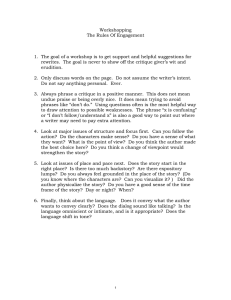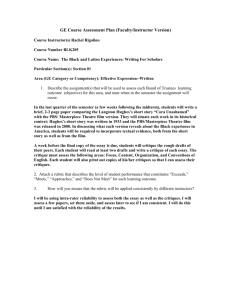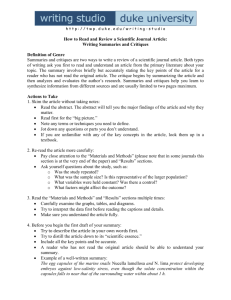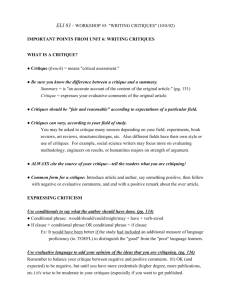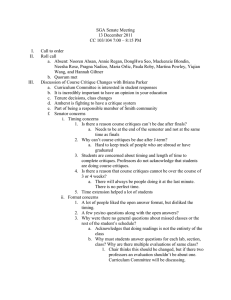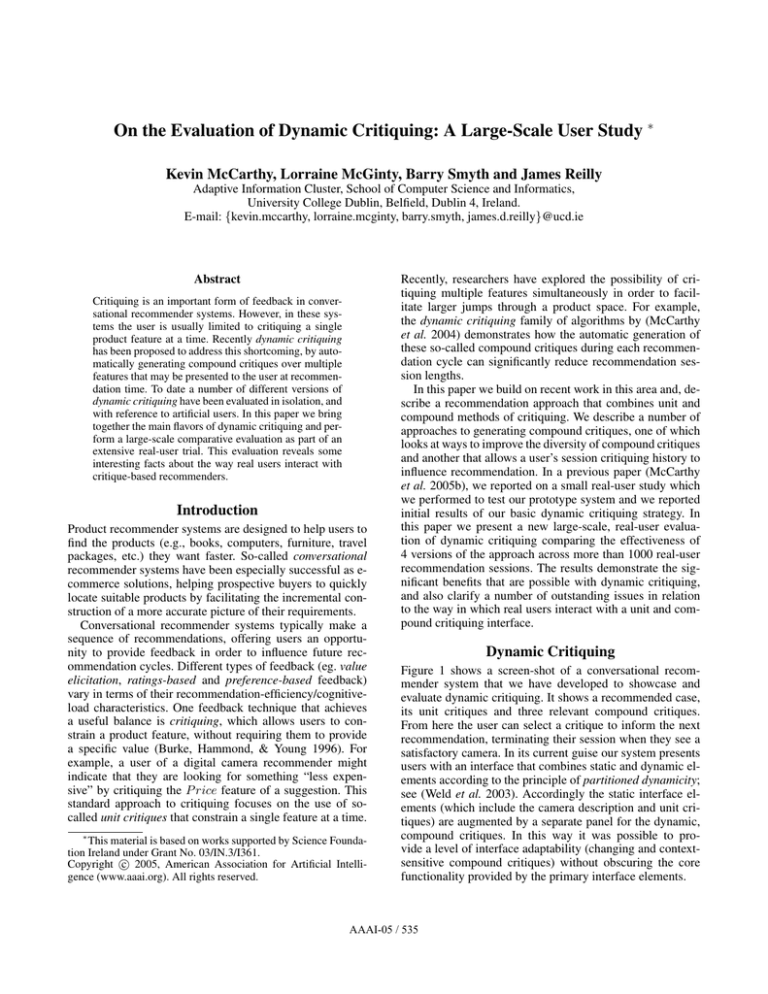
On the Evaluation of Dynamic Critiquing: A Large-Scale User Study ∗
Kevin McCarthy, Lorraine McGinty, Barry Smyth and James Reilly
Adaptive Information Cluster, School of Computer Science and Informatics,
University College Dublin, Belfield, Dublin 4, Ireland.
E-mail: {kevin.mccarthy, lorraine.mcginty, barry.smyth, james.d.reilly}@ucd.ie
Abstract
Critiquing is an important form of feedback in conversational recommender systems. However, in these systems the user is usually limited to critiquing a single
product feature at a time. Recently dynamic critiquing
has been proposed to address this shortcoming, by automatically generating compound critiques over multiple
features that may be presented to the user at recommendation time. To date a number of different versions of
dynamic critiquing have been evaluated in isolation, and
with reference to artificial users. In this paper we bring
together the main flavors of dynamic critiquing and perform a large-scale comparative evaluation as part of an
extensive real-user trial. This evaluation reveals some
interesting facts about the way real users interact with
critique-based recommenders.
Introduction
Product recommender systems are designed to help users to
find the products (e.g., books, computers, furniture, travel
packages, etc.) they want faster. So-called conversational
recommender systems have been especially successful as ecommerce solutions, helping prospective buyers to quickly
locate suitable products by facilitating the incremental construction of a more accurate picture of their requirements.
Conversational recommender systems typically make a
sequence of recommendations, offering users an opportunity to provide feedback in order to influence future recommendation cycles. Different types of feedback (eg. value
elicitation, ratings-based and preference-based feedback)
vary in terms of their recommendation-efficiency/cognitiveload characteristics. One feedback technique that achieves
a useful balance is critiquing, which allows users to constrain a product feature, without requiring them to provide
a specific value (Burke, Hammond, & Young 1996). For
example, a user of a digital camera recommender might
indicate that they are looking for something “less expensive” by critiquing the P rice feature of a suggestion. This
standard approach to critiquing focuses on the use of socalled unit critiques that constrain a single feature at a time.
∗
This material is based on works supported by Science Foundation Ireland under Grant No. 03/IN.3/I361.
c 2005, American Association for Artificial IntelliCopyright gence (www.aaai.org). All rights reserved.
Recently, researchers have explored the possibility of critiquing multiple features simultaneously in order to facilitate larger jumps through a product space. For example,
the dynamic critiquing family of algorithms by (McCarthy
et al. 2004) demonstrates how the automatic generation of
these so-called compound critiques during each recommendation cycle can significantly reduce recommendation session lengths.
In this paper we build on recent work in this area and, describe a recommendation approach that combines unit and
compound methods of critiquing. We describe a number of
approaches to generating compound critiques, one of which
looks at ways to improve the diversity of compound critiques
and another that allows a user’s session critiquing history to
influence recommendation. In a previous paper (McCarthy
et al. 2005b), we reported on a small real-user study which
we performed to test our prototype system and we reported
initial results of our basic dynamic critiquing strategy. In
this paper we present a new large-scale, real-user evaluation of dynamic critiquing comparing the effectiveness of
4 versions of the approach across more than 1000 real-user
recommendation sessions. The results demonstrate the significant benefits that are possible with dynamic critiquing,
and also clarify a number of outstanding issues in relation
to the way in which real users interact with a unit and compound critiquing interface.
Dynamic Critiquing
Figure 1 shows a screen-shot of a conversational recommender system that we have developed to showcase and
evaluate dynamic critiquing. It shows a recommended case,
its unit critiques and three relevant compound critiques.
From here the user can select a critique to inform the next
recommendation, terminating their session when they see a
satisfactory camera. In its current guise our system presents
users with an interface that combines static and dynamic elements according to the principle of partitioned dynamicity;
see (Weld et al. 2003). Accordingly the static interface elements (which include the camera description and unit critiques) are augmented by a separate panel for the dynamic,
compound critiques. In this way it was possible to provide a level of interface adaptability (changing and contextsensitive compound critiques) without obscuring the core
functionality provided by the primary interface elements.
AAAI-05 / 535
Figure 1: A digital camera recommender system that implements unit and compound critiquing.
The Standard Dynamic Critiquing Approach
In this section we outline how these compound critiques are
generated and discuss a number of techniques for improving
their quality. The standard approach to dynamic critiquing
has been previously described by (McCarthy et al. 2004).
The basic idea is that during every recommendation cycle,
in addition to selecting a new case to recommend to the user,
the system should also present a set of compound critiques
that characterise the remaining cases. For example, in Figure 1 we see an example of a compound critique leading
to 169 cases with less resolution and a different format for
a cheaper price. Generating these compound critiques involves 3 basic steps:
STEP 1 - Generating Critique Patterns: For a given
recommendation cycle each of the remaining cases is redescribed by a critique pattern which captures the relationship between each case and the current recommended case.
For example, Figure 2 shows an example from the Digital
the current set of critique patterns. This is similar to the
market-basket analysis task where the well-known Apriori
algorithm (Agrawal et al. 1996) has been used to characterize recurring itemsets as association rules of the form
A → B. During this stage, Apriori is applied during each
cycle to the remaining product cases in order to identify
groups of recurring unit critiques; we might expect to find
the co-occurrence of unit critiques like [Resolution >] infers [P rice >]. Apriori returns lists of compound critiques
of the form {[Resolution >], [P rice >]} along with their
support values (the percentage of critique patterns for which
the compound critique holds).
STEP 3 - Grading Compound Critiques: Of course it is
not practical to present large numbers of different compound
critiques as user-feedback options in each cycle. A filtering
strategy is used to select the k most useful critiques for presentation purposes based on their support values; compound
critiques with low support values have the ability to eliminate many product cases from consideration if chosen. The
work of (McCarthy et al. 2004) has looked at a number of
ways to filter critiques, concluding that preferring critiques
with low support values has the potential to offer the best
recommendation efficiency benefits.
Improving Critique Diversity
Sometimes the critique generation strategy can produce poor
quality compound critiques that are very similar to each
other, limiting their applicability. One potential solution to
this problem is to actively improve the diversity of compound critiques by including a direct measure of diversity
during critique selection. Similar issues have been investigated by (McGinty & Smyth 2003; Shimazu 2001), albeit
in a different recommender context. For example the diversity enhancing algorithm described by (Smyth & McClave
2001) selects items on the basis of a quality metric that maximizes similarity to some target item, while minimizing average similarity to the items selected so far. In (McCarthy et
al. 2005a) a similar quality metric is defined for compound
critiquing as shown by Equation 1, and a similar selection
strategy is used during critique selection; note cc stands for
the current compound critique being considered, C represents the set of critiques so far selected and U (C) is the set of
unit critiques that make up C. Priority is given to compound
critiques with low support scores, that are diverse relative to
any compound critiques that have been so far selected for
presentation to the user.
DQual(cc, C) = Support(cc) ∗ 1 −
Figure 2: Generating a critique pattern.
Camera domain. The resulting critique pattern reflects how
a case c differs from the current case in terms of individual
feature critiques. For example, the critique pattern shown includes a “<” critique for Resolution— we will refer to this
as [Resolution <]—because the comparison case has less
pixels than the current recommendation.
STEP 2 - Mining Compound Critiques: This step involves identifying recurring patterns of unit critiques within
|U ({cc}) ∩ U (C)|
|U ({cc}) ∪ U (C)|
(1)
Incremental Critiquing
Another problem with the standard approach stems from the
fact that when it comes to generating critiques for the current cycle, no direct consideration is given to feedback previously provided by users during a session. Many users may
not have a clear understanding of their requirements at the
beginning of a session and rely on the recommender as a
AAAI-05 / 536
means to educate themselves about features of a productspace (Sherin & Lieberman 2001; McCarthy et al. 2004;
Pu & Kumar 2004). Accordingly, users may select apparently incompatible critiques as they explore different areas
of the product space in order to build up a clearer picture
of what is available. For example, we might find a prospective camera owner seeking a camera that is cheaper than the
current 500 euro recommendation, but later asking for a recommendation that is more expensive than another 500 euro
option once they recognize the compromises that are associated with lower priced cameras (McSherry 2003). We believe that it is important to consider such interaction histories
when producing future recommendations.
Incremental Critiquing (Reilly et al. 2004) addresses
these problems by considering past critique selections in
each recommendation cycle. It does this by maintaining a
session-based user model made up of those critiques chosen
by the user so far. This model is given by U = {U1 , ..., Un },
where Ui is a single unit critique. During recommendation
this model is used to influence the choice of a new product case, along with the current critique. After a critique has
been selected the model is updated accordingly, with compound critiques separated into their constituent unit parts.
Maintaining an accurate user model, however, is not quite
as simple as storing a list of previously selected critiques. As
we have mentioned above, some critiques may be inconsistent with earlier critiques. For example, in the case of a Digital Camera recommender, a user selecting a critique for more
digital zoom, beyond the 5x of the recommended case, may
later contradict themselves by indicating a preference for
less digital zoom than the 3x offered by a subsequent case.
In addition, a user may refine their requirements over time.
They might start by indicating a preference for more than
3.1M Pixels resolution. Later they might indicate a preference for more than 5.0M Pixels. The incremental critiquing
strategy updates the user model by adding the latest critique
only after pruning previous critiques so as to eliminate these
sorts of inconsistencies. Specifically, prior to adding a new
critique all existing critiques that are inconsistent with it are
removed, as are all existing critiques for which the new critique is a refinement.
0
Compat(c , U ) =
P
∀i
satisf ies(Ui , c0 )
|U |
(2)
IQual(c0 , c, U ) = α∗Compat(c0 , U )+(1−α)∗Sim(c0 , c)
(3)
The theory behind the user model is that it should be
used to influence the recommendation process, prioritising
those product cases that are compatible with its critiques.
The standard approach to recommendation, when using critiquing, is a two step one. First, the remaining cases are filtered by eliminating all of those that fail to satisfy the current
critique. Next, these filtered cases are rank ordered according to their similarity to the current recommendation. Incremental critiquing makes one important modification to this
procedure. Instead of ordering the filtered cases on the basis
of their similarity to the recommended case, a compatibility
score for each candidate case is also computed. This compatibility score is essentially the percentage of critiques in
the user model that this case satisfies (see Equation 2 and
note that satisf ies(Ui , c0 ) returns 1 when the critique, Ui
satisfies the filtered case, c, and returns 0 otherwise). Thus,
a case satisfying 3 out of 5 critiques in a user model gets a
compatibility score of 0.6.
This compatibility score is then combined with the candidate’s (c0 ) similarity to the recommended product case, c,
in order to obtain an overall quality score as in Equation 3;
by default α = 0.75. This quality score is used to rank order the filtered cases prior to the next recommendation cycle
and the case with the highest quality is then chosen as the
new recommendation. This approach allows us to prioritise
those candidate cases that: (1) satisfy the current critique; (2)
are similar to the most recently recommended case; and (3)
satisfy many previous critiques. In so doing we are implicitly treating the past critiques in the user model as soft constraints for future recommendation cycles; it is not essential
for future recommendations to satisfy all of the previous critiques, but the more they satisfy, the better they are regarded
as recommendation candidates. Moreover, given two candidates that are equally similar to the previously recommended
case, the algorithm prefers the one that satisfies the greater
number of recently applied critiques.
Evaluation
We have previously reported on a small user study where we
showed rudimentary efficiency results for our basic dynamic
critiquing approach (McCarthy et al. 2005b). In this paper
we are especially interested in understanding how users interact with the compound critiques that are generated by the
different critiquing strategies. Firstly, we report on a direct
comparison between the different critique generation strategies, comparing their overall application frequency and session length characteristics; in particular we analyse the session length implications of low versus high usage frequencies. Secondly, we perform a more fine-grained analysis in
order to investigate when users tend to use compound critiques. We are especially interested in patterns of usage that
might indicate a propensity to use compound critiques at the
start of a session, in order to help the user to focus quickly in
on a relevant region of the product-space, with unit critiques
being used later in sessions, in order to fine-tune their requirements. Finally, we return to the issue of the frequencyof-use by asking whether there appears to be an optimal usage frequency that delivers the best efficiency gains. We answer these questions with reference to a large-scale real-user
trial we conducted during December 2004.
Setup
Users for our trial were made up of both undergraduate and
postgraduate students from the department of Computer Science at University College Dublin. Trial participants were
invited to use our Digital Camera Recommender (see Figure
1) during December 2004. The trial consisted of two parts.
In the first part, each trialist was asked to participate in a socalled training session so that they could become acquainted
AAAI-05 / 537
with the critiquing mode of interaction. Here they were presented with a specific camera case as a starting point and
then asked to shop from this case to locate their ideal camera. In the second part, they were presented with a fixed start
case and target case, and were asked to locate the target case
by using critiques (unit or compound) of their choice. There
were 25 different start–target pairs and these were randomly
assigned at the beginning of every session. Trialists were
permitted to use the system as often as they liked. This setup
ensured that any learning effect was minimised, which has
been confirmed but space restrictions prohibit further discussion.
Here we report on results from part 2 of the trial, which
generated 1092 user sessions from 76 unique users. The
trialists were made up of 53% undergraduate and 47%
postgraduate students with 61 male and 15 female participants. The different critiquing strategies; standard dynamic critiquing (Standard), dynamic critiquing with diversity (Standard-Diversity), incremental critiquing (Incremental) and incremental critiquing with diversity (IncrementalDiversity) were deployed during different days of this trial
and a variety of details were logged for each user session
(e.g., the camera cases presented, the critiques applied, etc.).
Overall Recommendation Efficiency
To be successful, recommender systems must be able to efficiently guide a user through a product-space and, in general, short recommendation sessions are to be preferred. Previously research by (McCarthy et al. 2004; 2005a; Reilly
et al. 2004) has demonstrated how the different dynamic
critiquing strategies are capable of delivering significantly
shorter sessions than unit critiquing. However, to date the
performance of these different strategies have not been compared directly. We do this now in Figure 3 where we present
the overall average session length and compound critique
application frequency for the different versions of our recommender system. The results clearly demonstrate that both
Summary Len x Freq
Comparative Recommendation Efficiency
While the previous results tell us about the relative performance of our different critiquing strategies, they do not directly inform us about the value of dynamic critiquing per
se (i.e., relative to unit critiquing). This question has been
partly answered by the work of (McCarthy et al. 2004)
through a direct comparison of dynamic and unit critiquing.
An alternative is to look for efficiency differences between
those sessions that contain few applications of compound
critiques (low frequency sessions) compared to high frequency sessions. To do this, for each recommendation strategy, we partition its sessions into two groups according to
the median application frequency for compound critiques
observed. This gives a set of low frequency sessions (those
that have application frequencies that are less than the median) and a set of high frequency sessions (where application
frequency is greater than or equal to the median).
18
15
30%
12
Mean Session Length
Mean Application Frequency
20%
9
6
10%
Mean Session Length
Mean Application Frequency
40%
Standard-Diversity is 13.5 cycles, compared to only 7.6 for
the average of Incremental and Incremental-Diversity; in
other words, the incremental critiquing strategies deliver
a 44% reduction in average session length. Interestingly,
we see that the diversity-enhancing strategy has a negative
impact on session length. Standard-Diversity leads to sessions that are 36% longer than Standard, and IncrementalDiversity delivers sessions that are almost 5% longer than
Incremental. When we look at application frequency (i.e.,
the frequency with which compound critiques are selected
by users during sessions) we see that the diversity-enhancing
strategy results in the more frequent application of compound critiques by our trial users; an average application
frequency of about 35% for the Standard-Diversity and
Incremental-Diversity techniques. That is, users are selecting compound critiques in 35% of the cycles and unit critiques in the remaining 65% of cycles, compared to an average of 24% for the Standard and Incremental techniques.
3
0%
0
Standard
StandardDiversity
Incremental
IncrementalDiversity
Strategy
Page 1
Figure 3: Overall recommendation efficiency results for the
four different dynamic critiquing strategies.
versions of the incremental critiquing approach (Incremental
and Incremental-Diversity) improve on both versions of the
(non-incremental) standard dynamic critiquing approaches.
For instance, the average session length for Standard and
Figure 4: Comparative recommendation efficiency results
for the four different dynamic critiquing strategies.
AAAI-05 / 538
Figure 5: The application frequency results for the four different dynamic critiquing strategies on a per cycle basis.
Application Frequency
Figure 4(a-d) presents the average session length for these
groupings of sessions, and their average compound critique application frequency, across all four recommendation
strategies. For each of the recommendation strategies we see
a significant (at the 99% confidence level) reduction in session length for sessions that tend towards more frequent use
of compound critiques (ranging from 35% to 55% application frequency) compared to the low frequency sessions
(with between 10% to 20% application frequency). For example, there is a 50% reduction in average session length
(11 vs. 21.8) for Standard (Figure 4(a)), a 20% reduction
for Standard-Diversity and Incremental and a 24% reduction for Incremental-Diversity.
Although these results strongly suggest that there is a significant benefit to be gained from the more frequent use
of compound critiques, it seems reasonable to ask if a sustained use of compound critiques will always deliver shorter
sessions, or is there typically an optimal usage frequency,
beyond which the benefits of compound critiques tend to
decline? Intuitively the latter seems more plausible. Compound critiques provide users with an opportunity to make
large jumps through the product-space, but they are not well
suited to taking more fine-grained steps. We attempt to answer these questions in this section.
Figure 5 graphs the application frequency of compound
critiques for different cycles, for our 4 recommender systems. That is, we count the percentage of sessions where
compound critiques are used in the first, second, third cycles, and so on. The graph demonstrates how compound critiques are more likely to be applied during the early cycles of
a session. We see that for all strategies compound critiques
are used in at least 50% of the first 3 cycles of a session; for
instance, for the Standard-Diversity strategy we see users
picking compound critiques in 86% of their first cycles.
To answer the question about whether there is an optimal application frequency for compound critiques, in Figure 6, we graph the average session length for sessions with
different application frequency ranges (0%-25%, 25%-50%,
50%-75%, 75%-100%), for each of the strategies. The data
reveals a common pattern for each of the recommendation
Figure 6: Average session length results for recommendation
sessions with different degrees of application frequency for
the four different dynamic critiquing strategies.
strategies, consistent with our results. Sessions in which
compound critiques are used infrequently (less than 25% of
the time) tend to be long, and more frequent use of compound critiques can produce significant reductions in average session length. This reduction appears to be available
only up to a certain point. In each case we find the shortest sessions to occur in the 50%-75% application frequency
range. Beyond this, session length begins to increase.
These results are consistent with the view that the compound critiques are best applied during the early stages
of a recommendation session and that they should not be
overused. Their value is derived from helping the user to
quickly focus in on a suitable region of the product space,
but unit critiques are better suited to the finer adjustments
that are needed during the final stages of recommendation.
Other Related Work
Our research builds directly on work originally described
by Burke et al. and implemented by the “FindMe” systems
(Burke, Hammond, & Young 1996). Although this past work
initially concentrated on the usefulness of unit critiques, the
FindMe systems also recognised the navigation benefits associated with allowing users to manipulate multiple features
simultaneously. Some FindMe systems presented the user
with compound critique options. However they adopted a
fixed interaction style, presenting a static set of critiques to
the user during each cycle. There are problems with this approach. The static compound critiques may not be particularly relevant to the user or they may refer to critiques that
do not satisfy any remaining product cases; problems that do
not arise with our approach.
“Apt Decision” acts as an advisor to a consumer by inferring general preference orderings from a history of explicit unit critiques in response to specific examples (Sherin
& Lieberman 2001). User preference profiles are collected
implicity by the system and used in subsequent recommen-
AAAI-05 / 539
dation sessions. This shares some similarities with the incremental critique approach except that the this system maintains persistent critique profiles for each user whereas our
approach uses short-term session-based profiles.
Finally, the example-critiquing approach, implemented as
the “SmartClient” tool (Faltings et al. 2004; Pu & Kumar
2004), proposes a more user-centric mode of interaction.
Users can critique examples (e.q., travel plans) by directly
indicating preferences for individual or combinations of features (e.g., travel time and price); essentially the user can
build their own compound critiques during each cycle. The
approach is also incremental in nature, in the sense that
recently applied critiques influence subsequent retrievals.
However, a key difference with our work is that we proactively select a set of diverse compound critiques for the
user — rather than just allowing the user to select combinations of critiques — that are adapted to their current cycle.
Conclusions
Critiquing is an important user-feedback strategy in conversational recommender systems. Recently researchers have
extended the standard approach to critiquing to accommodate the use of dynamic, compound critiques that facilitate
feedback on multiple features simultaneously. Past results
indicate that these extensions have the potential to deliver
significant advantages when it comes to recommendation efficiency and quality, but previous results have been limited
by their reliance on artificial user data and the lack of any
significant comparative analysis in order to evaluate the relative merits of the different flavours of dynamic critiquing.
In this paper we address these issues by evaluating 4 different versions of dynamic critiquing through a large-scale
user trial. The results show that incremental critiquing offers significant efficiency benefits over the standard form
of critiquing, backing up artificial user studies presented by
(McCarthy et al. 2004). However, they also show that the
diversity-enhancements lead to reductions in recommendation efficiency, contradicting the former studies.
Interestingly, our analysis reveals a number of new results in relation to the manner in which users interact with
the compound critiques that are generated by the dynamic
critiquing techniques. We see that the diversity-enhancing
methods produce compound critiques that are more likely
to be selected by users, even though these selections do not
favour recommendation efficiency. We also find that users
seem to use compound critiques frequently during the early
stages of a session, in order to focus in on the right general
region of a product-space, but rarely in the latter stages of a
session, where they prefer to use unit critiques to fine-tune
their requirements on a feature-by-feature basis.
References
Agrawal, R.; Mannila, H.; Srikant, R.; Toivonen, H.; and
Verkamo, A. I. 1996. Fast Discovery of Association Rules
in Large Databases. Advances in Knowledge Discovery and
Data Mining 307–328.
Burke, R.; Hammond, K.; and Young, B.
1996.
Knowledge-based Navigation of Complex Information
Spaces. In Proceedings of the Thirteenth National Conference on Artificial Intelligence, 462–468. Portland, OR.
Faltings, B.; Pu, P.; Torrens, M.; and Viappiani, P. 2004.
Designing Example-Critiquing Interaction. In Proceedings of the International Conference on Intelligent User
Interface(IUI-2004), 22–29. Funchal, Madeira, Portugal.
McCarthy, K.; Reilly, J.; McGinty, L.; and Smyth, B. 2004.
On the Dynamic Generation of Compound Critiques in
Conversational Recommender Systems. In Bra, P. D.,
ed., Proceedings of the Third International Conference on
Adaptive Hypermedia and Web-Based Systems (AH-04),
176–184. Springer. Eindhoven, The Netherlands.
McCarthy, K.; Reilly, J.; McGinty, L.; and Smyth, B.
2005a. An Analysis of Critique Diversity in Case-Based
Recommendation. In Proceedings of the Eighteenth International FLAIRS Conference (FLAIRS-05). AAAI Press.
Clearwater Beach, Florida, USA.
McCarthy, K.; Reilly, J.; McGinty, L.; and Smyth, B.
2005b. Experiments in Dynamic Critiquing. In Riedl, J.;
Jameson, A.; Billsus, D.; and Lau, T., eds., Proceedings of
the International Conference on Intelligent User Interfaces
(IUI’05), 175–182. ACM Press. San Diego, CA, USA.
McGinty, L., and Smyth, B. 2003. The Role of Diversity
in Conversational Systems. In Bridge, D., and Ashley, K.,
eds., Proceedings of the Fifth International Conference on
Case-Based Reasoning (ICCBR-03), 276–290. Springer.
Troindheim, Norway.
McSherry, D. 2003. Balancing User Satisfaction and Cognitive Load in Coverage-Optimised Retrieval. In Coenen,
F.; Preece, A.; and Macintosh, A., eds., Research and Development in Intelligent Systems XX. Proceedings of AI2003, 381–394. Springer-Verlag. Cambridge, UK.
Pu, P., and Kumar, P. 2004. Evaluating Example-based
Search Tools. In Proceedings of the ACM Conference on
Electronic Commerce (EC’04), 208–217. New York, USA.
Reilly, J.; McCarthy, K.; McGinty, L.; and Smyth, B. 2004.
Incremental Critiquing. In M. Bramer, F. C., and Allen,
T., eds., Research and Development in Intelligent Systems
XXI. Proceedings of AI-2004, 101–114. Cambridge, UK.
Sherin, S., and Lieberman, H. 2001. Intelligent Profiling by
Example. In Proceedings of the International Conference
on Intelligent User Interfaces (IUI 2001), 145–152. ACM
Press. Santa Fe, NM, USA.
Shimazu, H. 2001. ExpertClerk : Navigating Shoppers’ Buying Process with the Combination of Asking and
Proposing. In Nebel, B., ed., Proceedings of the Seventeenth International Joint Conference on Artificial Intelligence (IJCAI-01), 1443–1448. Seattle, WA, USA.
Smyth, B., and McClave, P. 2001. Similarity vs Diversity.
In Aha, D., and Watson, I., eds., Proceedings of the International Conference on Case-Based Reasoning, 347–361.
Weld, D.; Anderson, C.; Domingos, P.; Etzioni, O.; Lau, T.;
Gajos, K.; and Wolfman, S. 2003. Automatically Personalizing User Interfaces. In Proceedings of the 18th International Joint Conference Artificial Intelligence (IJCAI-03),
1613–1619. Morgan Kaufman. Acapulco, Mexico.
AAAI-05 / 540

